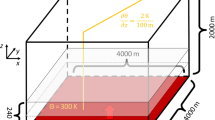Abstract
Introducing the surface properties [initial vortex, ground temperature and surface momentum impact height (SMIH)] for the boundary conditions, dust-devil-scale large eddy simulations (LES) were carried out. Given three parameters of initial vortex, ground temperature and the SMIH based on Sinclair’s observation, the dust devil physical characteristics, such as maximum tangential velocity, updraft velocity, pressure drop in the inner core region, and even reverse flow at the top of the core region, are predicted, and are found to be close to the observations, thus demonstrating the ability of the simulation. The physical characteristics of different modeled dust devils are reproduced and compared to the values predicted by Renno et al.’ theory. Even for smaller temperature differences or weaker buoyancy, severe dust devils may be formed by strong incipient vortices. It is also indicated that SMIH substantially affects the near-surface shape of terrestrial dust devils.
Similar content being viewed by others
References
Battan, L. J., 1958: Energy of a dust devil. J. Meteor., 15, 235–237.
Cantor, B., M. Malin, and K. S. Edgett, 2002: Multi-year Mars Orbiter Camera (MOC) observations of repeated Martian weather phenomena during the northern summer season. J. Geophys. Res. E, 107(3), 5014, doi:10.1029/2001JE001588.
Cortese, T., and S. Balachandar, 1993: Vertical nature of thermal plumes in turbulent convection. Physics of Fluids A, 5, 3226–3232.
Greeley, R., M. R. Balme, J. D. Iversen, S. Metzger, R. Mickelson, J. Phoreman, and B. White, 2003: Martian dust devils: Laboratory simulations of particle threshold. J. Geophys. Res. E, 108(5), 7–1.
Green, S. I., 1995: Fluid Vortices. Kluwer Academic Publishers, Dordrecht, Netherlands, 878pp.
Gu, Z., Y. Zhao, Y. Li, Y. Yu, and X. Feng, 2006: Numerical simulation of dust lifting within dust devils-simulation of an intense vortex. J. Atmos. Sci., 63, 2630–2641.
Hess, G. D. and K. T. Spillane, 1990: Characteristics of dust devils in Australia. J. Appl. Meteor., 29, 498–507.
Ives, R. L. 1947: Behavior of dust devils. Bull. Amer. Meteor. Soc., 28, 168–174.
Kanak, K. M., 2005: Numerical simulation of dust devil-scale vortices. Quart. J. Roy. Meteor. Soc., 131, 1271–1292.
Kanak, K. M., D. K. Lilly, and J. T. Snow, 2000: The formation of vertical vortices in the convective boundary layer. Quart. J. Roy. Meteor. Soc., 126, 2789–2810.
Leslie, L. M., and R. K. Smith, 1977: On the choice of radial boundary conditions for numerical models of sub-synoptic vortex flows in the atmosphere, with application to dust devils. Quart. J. Roy. Meteor. Soc., 103, 499–510.
Leovy, C. B., 2003: The devil is in the dust. Nature, 424(6952), 1008–1009.
Li, J. F., 2002: Desert Climate. China Meteorological Press, Beijing, 185pp. (in Chinese)
Lilly, D. K., 1992: A proposed modification of the Germano subgrid-scale closure method. Physics of Fluids A, 4(3), 633–635.
Michaels, T. I., and S. C. R. Rafkin, 2004: Large eddy simulation of atmospheric convection on Mars. Quart. J. Roy. Meteor. Soc., 130(599), 1251–1274.
Nieuwstadt, F. T. M., M. Mason, J. P. Moeng, and U. Schumann, 1991: Large eddy simulation of the convection boundary layer: A comparison of four computer codes. Proc. 8th Symposium on Turbulent Shear Flows, Springer-Verlag, 651–664.
Renno, N. O., and H. B. Bluestein, 2001: A simple theory for waterspouts. J. Atmos. Sci., 58, 927–932.
Renno, N. O., M. L. Burkett, and M. P. Larkin, 1998: A simple thermodynamical theory for dust devils. J. Atmos. Sci., 55, 3244–3252.
Renno, N. O., and Coauthors, 2004: MATADOR 2002: A pilot field experiment on convective plumes and dust devils. J. Geophys. Res. E, 109, 1–10.
Ryan, J. A., and I. J. Carroll, 1970: Dust devils wind velocities: Mature state. J. Geophys. Res., 75, 531–541.
Shapiro, A., and Y. Kogan, 1994: On vortex formation in multicell convective clouds in a shear-free environment. Atmospheric Research, 33, 125–136.
Shapiro, A., and K. M. Kanak, 2002: Vortex formation in ellipsoidal thermal bubbles. J. Atmos. Sci., 59, 2253–2269.
Shen, Z., J. Cao, X. Li, T. Okuda, Y. Wang, and X. Zhang, 2006: Mass concentration and mineralogical characteristics of aerosol particle collected at Dunhuang during ACE-Asia. Adv. Atmos. Sci., 23(2), 291–298.
Sinclair, P. C., 1966: A quantitative analysis of the dust devil. Ph. D. dissertation, University of Arizona, 292pp.
Sinclair, P. C., 1973: The lower structure of dust devils. J. Atmos. Sci., 30, 1599–1619.
Smagorinsky, J., 1963: General circulation experiments with the primitive equations: Part I, The basic experiment. Mon. Wea. Rev., 91, 199–164.
Snow, J. T., 1982: A review of recent advances in tornado vortex dynamics. Rev. Geophys. Space Phys., 20, 953–964.
Vatistas, G. H., V. Kozel, and W. C. Mih, 1991: Simpler model for concentrated vortices. Experimental Fluids, 11, 73–76.
Wang, M., Q. Liu, and X. Yang, 2004: A review of research on human activity induced climate change I greenhouse gases and aerosols. Adv. Atmos. Sci., 21(3), 314–321.
Willis, G. E., and J. W. Deardorff, 1979: Laboratory observations of turbulent penetrative convection platforms. J. Geophys. Res., 84, 296–301.
Zhao, Y. Z., 2004: Large eddy simulation of dust devils. Ph. D. dissertation, Xi’an Jiaotong University, China, 160pp. (in Chinese).
Zhao, Y. Z., Z. L. Gu, Y. Z. Yu, Y. Ge, Y. Li, and X. Feng, 2004: Mechanism and large eddy simulation of dust devils. Atmos.-Ocean, 42, 61–84.
Author information
Authors and Affiliations
Corresponding author
Rights and permissions
About this article
Cite this article
Gu, Z., Qiu, J., Zhao, Y. et al. Simulation of terrestrial dust devil patterns. Adv. Atmos. Sci. 25, 31–42 (2008). https://doi.org/10.1007/s00376-008-0031-7
Received:
Revised:
Issue Date:
DOI: https://doi.org/10.1007/s00376-008-0031-7




